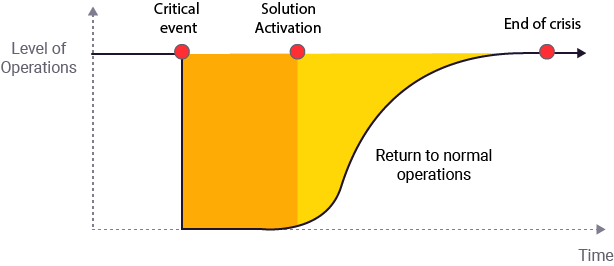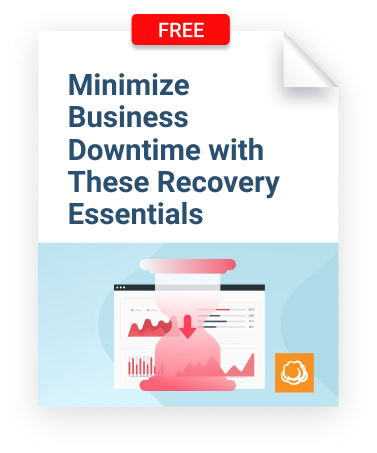The Recovery Time Objective (RTO) answers to “How quickly do we need to recover after a failure?”. So, what is RTO really? It's the maximum downtime for a system, application, or service.
This article explains the definition and the RTO meaning in disaster recovery planning.
What is RTO or Recovery Time Objective in Disaster Recovery
RTO is a key component of backup and disaster recovery planning (DRP). Service downtime always causes financial and operational damage, so organizations strive to restore from a failure within some reasonable time. This reasonable time, agreed upon by IT service and business stakeholders, is the Recovery Time Objective.
To better understand RTO, let’s look at the timeline of a disaster recovery event:
1. Failure Event
It is an event when a failure occurs, such as hardware failure, cyberattack, or data corruption.
2. Response Start Time
It's the time when recovery solution activates, such as restoring backups and/or switching to a failover system.
3. Full Recovery
is when the system is fully restored, and business operations resume as before.
The total time between the Failure Event and Full Recovery is the actual recovery time. The goal of disaster recovery planning is to ensure that this time stays within the defined RTO.

Why you need to know what is RTO to assess financial losses
RTO is important because every minute of downtime can cost businesses money. The longer systems remain unavailable, the more an organization risks:
- Lost revenue due to disrupted operations
- Productivity loss as employees are unable to work
- Customer dissatisfaction and potential churn
- Regulatory penalties if downtime affects compliance
This is why the Recovery Time Objective should be defined by business stakeholders. RTO must align with the business impact of downtime, ensuring that each system has an appropriate RTO based on its importance.
Example of what is RTO
- A mission-critical banking system
may require an RTO of just a few minutes to avoid severe financial loss.
- An internal HR system
may have an RTO of several hours, as it doesn’t impact revenue immediately.
Minimize Business Downtime with These Recovery Essentials
-
Direct-to-cloud recovery
-
Recovery with bootable drive
-
File-level and VM restore
-
Remote recovery


Lower RTO (Recovery Time Objective) Increases IT Costs
Achieving the Recovery Time Objective requires investment in IT infrastructure and recovery solutions. Reducing RTO may involve:
- Advanced backup strategies, such as continuous data replication
- High-availability (HA) systems that run continuously to minimize downtime
- Cloud-based disaster recovery solutions with rapid failover capabilities
- Automated recovery orchestration to reduce manual intervention
The cost of achieving a low RTO increases exponentially as recovery time approaches zero downtime. This is why organizations must find a balance—ensuring RTO is as low as necessary but not lower than required.
A practical approach is to tier recovery objectives based on business priorities. For example:
| System Type | Target RTO | Recovery Strategy |
|---|---|---|
| Critical business services | < 15 min | Redundant systems, failover clusters, continuous replication |
| Core operational services | < 1 hour | Automated recovery, offsite backups |
| Non-critical services | 4-12 hours | Regular backups, manual restoration |
This approach will help you use resources efficiently and meet the business requirements.
Achieving RTO (Recovery Time Objective)
Now you know how important it is to define the right RTO. Let’s look at the steps needed to achieve it effectively:
- Define your backup and recovery strategy. Start with comparing Recovery Time Objective vs. Recovery Point Objective (RPO).
- Create a proper monitoring system. Detect failures as early as possible to minimize downtime.
- Set up automated and regular backups. Ensure you always have up-to-date data for recovery.
- Define the restoration procedure. Include both automated recovery workflows and instructions for IT personnel.
- Test the backup and recovery plan. Conduct regular disaster recovery testing to identify bottlenecks and weaknesses.
Following these steps will ensure your RTO is achievable, cost-effective, and aligned with business needs. If you find achieving RTO too difficult or costly, reassess it with business stakeholders.
Sum up of what is RTO
- RTO defines the maximum acceptable downtime before a failure impacts business operations.
- Higher RTO increases financial risk, as longer downtime can lead to revenue loss and other damage.
- Lower RTO increases IT costs, as it requires more advanced recovery solutions.
- A balanced approach is essential. You should define RTO carefully with stakeholders and ensure that you use IT resources efficiently.
- Achieving RTO requires proper planning, automation, monitoring, and regular testing.
By optimizing RTO within reasonable limits, businesses can minimize downtime, control costs, and maintain operational resilience.






